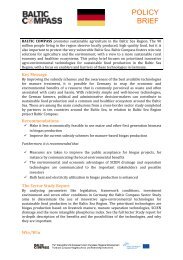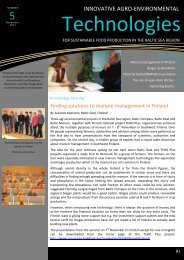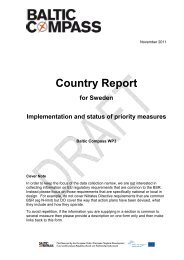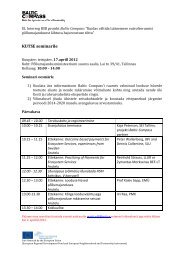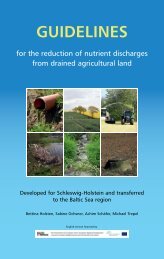A_Greener_2011_Sånga-Säby - Baltic Deal
A_Greener_2011_Sånga-Säby - Baltic Deal
A_Greener_2011_Sånga-Säby - Baltic Deal
Create successful ePaper yourself
Turn your PDF publications into a flip-book with our unique Google optimized e-Paper software.
Conference report: A <strong>Greener</strong> Agriculture for a Bluer <strong>Baltic</strong> Sea, <strong>2011</strong>12are used for HELCOM reporting of Swedish agricultural loads to the <strong>Baltic</strong> Sea.ICECREAMDB and SOILNDB are used for simulation of P and N respectively.Some of the results collected from the first run are earlier start of growth period forperennial crops in spring and later ending of growth period in autumn. There are alsoestimations in changes in N- and P-losses due to future climate change. The presentation endswith an account of CO2 scenarios.Sirkka Tattari from Finnish Environmental Institute held a presentation about BestAvailable Measures Now and in the Future: the Modelling AspectsFirst Sirkka Tattari presented the characteristics of the Aurajoki site and the VIHMAexperimental sites. She showed a table of the average loading values with different cultivationpractices as estimated with VIHMA model (see annex 4 for link to presentation)The different parameters in the VIHMA system are classed into:Slope, soil type, cultivation, P-status and condition of drainage.In Aurajoki there have been long term field measurements such as cultivation of grass ley,stubble, winter rye/wheat and normal ploughing. The negative impacts on the environmentfrom these measures are estimated under different combinations of parameters. Examples ofmeasures used in Aurajoki are more accurate nitrogen fertilization, plant cover during winter,cultivation of catch crops etc. Some of the effects from these measures can be estimated (followlink in annex 4 to presentation for examples).Part 2 – the Greening of CAPChair in this part of the seminar was Didzis Neimanis from Latvian Farmer’s ParliamentNeil Powell from <strong>Baltic</strong> Compass, gave a presentation on the Institutional Challenges inImplementing “Best” Practices in the <strong>Baltic</strong> Sea Region. Please see annex 4 for link topresentation.Ola Palm from JTI held a presentation on the Lessons on the Identification of Best Practices in<strong>Baltic</strong> Sea Region.What is meant by best practices?• Well known and documented measures• Used today• Proven to have an effect• Of interest and possible to implement for most BSR-farmers• Including management measures and not only technologiesWhen it comes to best practices, there are a lot of well known measures that are not fullyimplemented, and there are large variations in what is used between, and within countries.There is also great variation in agricultural structure between countries in BSR, as well as infarmers’ income. Ola Palm thinks it’s important to catch the differences in the ways wethink and practice.The conference was co-financed by the European Union (European Regional Development Fund and European Neighbouringand Partnerships Instrument) and organised by the project cluster <strong>Baltic</strong> Compass, <strong>Baltic</strong> <strong>Deal</strong> and <strong>Baltic</strong> Manure



